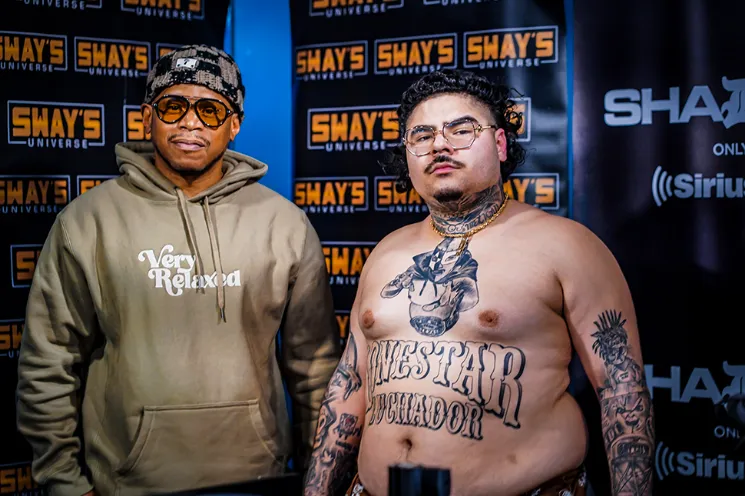That Mexican OT, whose real name is Virgil René Gazca, is 25 years old. He was born on February 2, 1999.
The Ot Age in Mexican history intrigues many. It spans a time filled with unique traditions, significant developments, and remarkable contributions to the broader cultural landscape. During this era, Indigenous communities thrived, each contributing to Mexico’s rich tapestry.
Understanding the Ot Age helps us appreciate the depth of Mexican heritage. It reveals stories of resilience, innovation, and profound societal changes. This period offers a window into the lives of the people who shaped modern Mexico. Join us as we explore the key elements and significance of the Mexican Ot Age, shedding light on its lasting impact on contemporary Mexican culture.
Quick Bio
| Category | Details |
| Full Name | Virgil Rene Gazca |
| Stage Name | Mexican OT |
| Date of Birth | March 23, 1999 |
| Age | 25 years (as of 2024) |
| Birthplace | Bay City, Texas, USA |
| Ethnicity | Mexican-American |
| Nationality | American |
| Height | 5 feet 9 inches (175 cm) |
| Weight | 165 lbs (75 kg) |
| Body Type | Athletic |
| Eye Color | Brown |
| Hair Color | Black |
| Family | Details about his family are private; he frequently references cultural ties. |
| Relationship Status | It’s likely single (as of recent updates; not publicly confirmed). |
| Career | Rapper and songwriter known for tracks blending Southern hip-hop with Mexican-American culture. |
| Breakout Hit | “Johnny Dang” featuring Paul Wall and DRODi |
| Net Worth | Approximately $500,000 (as of 2024) |
| Source of Income | Music sales, streaming, performances, and merchandise |
| Body Measurements | Chest: 40 inches, Waist: 32 inches, Biceps: 14 inches |
| Genres | Hip-hop, Southern rap |
| Social Media | Active on Instagram, YouTube, and TikTok |
| Notable Collaborations | Paul Wall, DRODi, and other Southern rap artists |
Who Is Mexican ot?

The “Mexican OT,” whose real name is Virgil Rene Gazca, is a rising rapper and songwriter from Bay City, Texas. Known for his high-energy performances and distinctive musical style, he blends Southern hip-hop beats with Mexican-American cultural influences, creating a sound that resonates deeply with a diverse audience. Mexican OT’s music often reflects his life experiences, cultural pride, and the challenges he faced in his upbringing.
Born and raised in a predominantly Latino community, Mexican OT found inspiration in his heritage, incorporating bilingual lyrics and references to Mexican culture into his tracks. He began gaining attention in the underground hip-hop scene for his unique flow, charismatic delivery, and ability to tell vivid stories through his music. His breakout single, “Johnny Dang,” featuring Paul Wall and DRODi, propelled him into the spotlight, garnering millions of streams and widespread recognition.
Mexican OT’s music is characterized by its gritty beats, humorous punchlines, and a seamless fusion of English and Spanish lyrics. His style pays homage to Southern rap legends while introducing a fresh perspective that reflects his cultural roots. He often collaborates with other artists, showcasing his versatility and ability to adapt to various sounds and styles.
Beyond music, Mexican OT uses his platform to celebrate Mexican-American identity and connect with fans who share similar experiences. His authenticity and relatability have earned him a dedicated fanbase, and he continues to gain momentum in the rap industry. With a promising career ahead, Mexican OT is poised to become a prominent figure in hip-hop.
Ancient Mexican Civilizations
Ancient Mexican civilizations are rich in history and culture. They left behind impressive structures and artifacts and contributed significantly to modern Mexican culture. Let’s explore some of these ancient civilizations.
Olmecs
The Olmecs are one of the earliest known civilizations in Mexico. They lived around 1200 to 400 B.C. and were centered in the Gulf Coast region. The Olmecs are famous for their colossal stone heads, carved from large basalt boulders and weighing several tons. They also developed a writing system and a calendar and are often called the “mother culture” of Mesoamerica.
Mayans
The Mayans flourished in southeastern Mexico, Guatemala, and Belize. Their civilization peaked between 250 and 900 A.D. The Mayans built impressive cities like Tikal and Chichen Itza. They excelled in mathematics and astronomy. The Mayans created a complex calendar system and developed a unique form of hieroglyphic writing. Their art and architecture are admired to this day.
Aztecs
The Aztecs ruled central Mexico from the 14th to 16th centuries. Their capital city was Tenochtitlan, located where Mexico City stands today. The Aztecs were skilled engineers and builders. They constructed grand temples and palaces. They practiced agriculture on floating gardens called chinampas. Their society was highly organized and had a strong military. The Aztecs also created a rich mythology and religious practices.
Diet And Nutrition
The diet and nutrition of ancient Mexicans, known as Mexicans of the Old Age, were rich and diverse. Their foods are still celebrated today. They relied on fresh, natural ingredients, which provided essential nutrients. Let’s explore their staple foods, traditional recipes, and the herbs and spices they use.
Staple Foods
The Mexican Ot Age had several staple foods. These foods were the foundation of their diet.
- Corn was their main food. They used it in many dishes and ground it into flour for tortillas and tamales.
- Beans: Beans provide protein. They often paired them with corn. This combination made a complete protein.
- Squash: Squash was another key food. They ate both the flesh and seeds. It was nutritious and versatile.
- Chili Peppers: Chili peppers added flavor and heat. They were used in many recipes.
Traditional Recipes

Traditional recipes from the Mexicans of the Ot Age are still popular. They are known for their rich flavors and nutritional value.
- Tamales: Tamales are made from corn dough. They are filled with meat or vegetables. Wrapped in corn husks, they are steamed until cooked.
- Tortillas: Tortillas are thin flatbreads made from corn flour and cooked on a griddle. They are the base for many dishes.
- Pozole: Pozole is a hearty soup. It includes hominy, meat, and chili peppers. It is often garnished with radishes, lettuce, and lime.
Herbs And Spices
Herbs and spices played a big role in their diet. They added flavor and medicinal benefits.
- Cilantro: Cilantro was used fresh. It added a bright, citrusy flavor to dishes.
- Oregano: Oregano was used dried. It provided a robust, earthy taste.
- Epazote: Epazote was a common herb. It was used to flavor beans and reduce gas.
- Cumin: Cumin added a warm, nutty flavor. It was used in many spice blends.
Physical Activity And Lifestyle
Physical activity and lifestyle play a big role in the lives of Mexican Otomi people. Their daily routines, traditional sports, and manual labor keep them active and healthy. These activities are part of their culture and help maintain their physical well-being.
Daily Routines
The daily routines of the Otomi people are filled with physical tasks. They often start their day early in the morning. This includes farming, taking care of animals, and gathering food. These tasks require strength and stamina. Walking long distances is also common. This keeps them fit and strong.
Traditional Sports
Traditional sports are another important part of their lifestyle. One popular sport is the “pelota mixteca.” It’s similar to tennis but played with a heavy ball. This sport requires quick movements and strong arms. Another sport is “ulama,” an ancient Mesoamerican ball game. These games keep the community active and bring them together.
Manual Labor
Manual labor is a big part of their daily life. Many Otomi work in agriculture, growing crops and raising livestock. They also engage in crafting, weaving, and building. These activities involve physical effort and skill. They contribute to their overall health and fitness. Manual labor ensures they stay active and maintain a strong body.
Medicinal Practices
The Mexican Ot Age boasts rich and unique medicinal practices. These practices are deeply rooted in tradition and culture. They offer natural remedies and spiritual healing methods. Let’s explore some of these fascinating practices.
Herbal Remedies
Herbal remedies play a crucial role in Mexican Ot Age medicine. Healers use plants and herbs to treat various ailments. Common herbs include:
- Echinacea: Boosts the immune system.
- Chamomile: Helps with sleep and digestion.
- Mint: Relieves headaches and nausea.
Healers prepare these herbs in different forms. They may use teas, poultices, or tinctures. These natural remedies have been passed down through generations.
Healing Rituals
Healing rituals are an essential part of the medicinal practices. These rituals often involve spiritual elements. They aim to restore balance and harmony in the body. Some common rituals include:
- Temazcal: A traditional steam bath for purification.
- Curanderismo: A holistic healing practice involving herbs, prayers, and rituals.
Experienced healers often lead these rituals. They believe in the power of the mind, body, and spirit working together.
Medicine Men And Women
Medicine men and women hold a respected position in the community. They are knowledgeable about herbs, rituals, and spiritual practices. Their role includes:
| Role | Description |
| Herbalist | Specializes in the use of medicinal plants. |
| Shaman | Conducts spiritual healing ceremonies. |
| Midwife | Assists in childbirth using traditional methods. |
These healers undergo extensive training. They pass their knowledge to the next generation. Their wisdom and skills are highly valued in the community.
Spiritual Beliefs
The spiritual beliefs of the Mexican Ot Age are rich and varied. These beliefs guide daily life and connect people to their heritage. They include a deep respect for nature and various rituals and ceremonies. Let’s explore these aspects in more detail.
Religious Practices
Religious practices in the Mexican Ot Age are deeply rooted in tradition. People worship many gods and goddesses, each representing different aspects of life. Temples and shrines are common places of worship.
Key practices include:
- Daily prayers and offerings
- Festivals celebrating gods and goddesses
- Community gatherings for worship
Connection To Nature
The Mexican Ot Age people have a strong connection to nature. They believe that all living things have a spirit. This belief influences their way of life and their respect for the environment.
Important aspects of their connection to nature include:
- Respecting animals and plants
- Using natural resources wisely
- Celebrating seasonal changes
Rituals And Ceremonies
Rituals and ceremonies play a significant role in the Mexican Ot Age. These events mark important life stages and community milestones. They also honor the gods and the spirits of nature.
Key rituals and ceremonies include:
| Ritual/Ceremony | Description |
| Birth Rituals | Ceremonies to welcome new life |
| Harvest Festivals | Celebrations of a successful harvest |
| Marriage Ceremonies | Events to bless unions |
Community And Social Structure

In the heart of Mexican Ot Age lies a vibrant community that thrives on strong bonds and shared values. The social structure is intricate yet fascinating. Let’s explore the key elements of this community through the lens of Family Roles, Elders’ Wisdom, and Social Support Systems.
Family Roles
Family holds a central place in the Mexican Ot Age society. Each member has a specific role, contributing to the family unit. Men often take the role of providers, while women manage the household. Children learn early to respect their elders and contribute to family chores.
The family structure often extends to include grandparents, aunts, uncles, and cousins. This extended family system provides a strong support network. Celebrations and gatherings are frequent, strengthening family bonds. Everyone works together to maintain harmony and balance within the family.
Elders’ Wisdom
Elders are highly respected in Mexican Ot Age communities. Their wisdom and experience are invaluable. They often act as advisors, guiding the younger generation through life’s challenges. Elders share stories, traditions, and cultural values, ensuring heritage preservation.
Many communities have specific roles for elders. For instance, they may lead ceremonies or resolve conflicts. Their knowledge of history and customs is essential in keeping the community’s identity alive. Respect for elders is deeply ingrained in the societal fabric.
Social Support Systems
The community thrives on robust social support systems. Neighbors help each other in need, fostering a sense of belonging. Social gatherings and communal activities are common, encouraging interaction and cooperation.
Community members often participate in collective efforts like building projects or agricultural work. These activities strengthen communal ties and promote mutual support. Social networks extend beyond family, creating a wide web of support and solidarity.
Mutual aid societies and local organizations play a crucial role. They provide resources and assistance to those in need. These support systems ensure that no one is left behind, enhancing the community’s overall well-being.
Environmental Factors
Understanding the environmental factors influencing the Mexican Ot Age is key. These factors shape their daily lives and long-term sustainability. Let’s dive into the key aspects, such as climate, sustainable living, and natural resources.
Climate And Geography
Due to its vast geography, Mexico boasts a diverse climate. The country’s weather varies greatly from arid deserts in the north to lush rainforests in the south. The central highlands experience cooler temperatures, while coastal areas enjoy tropical climates.
This variety impacts the Mexican Ot Age in many ways. Agricultural practices, for instance, differ across regions, affecting local food production. The unique geography also influences the availability of natural resources, which are crucial for daily life and economic activities.
Sustainable Living
Sustainable living is vital in Mexico. Communities focus on preserving their environment through various practices. Traditional farming techniques, for example, are still widely used. These methods reduce the use of harmful chemicals and support biodiversity.
Many Mexican households also practice recycling and waste reduction. Water conservation is another key aspect. Rainwater harvesting systems are common, especially in rural areas. These efforts help maintain the balance between human activities and nature.
Natural Resources
Mexico is rich in natural resources, including minerals, oil, and natural gas, which play a significant role in the country’s economy. Agriculture is also vital, with crops like corn, beans, and avocados being staples.
Forests and jungles provide timber and other forest products. The coastal areas offer abundant marine resources. These natural resources support the economy and contribute to the culture and traditions of the Mexican Ot Age.
Lessons For Modern Longevity
Ancient Mexican Ot Age offers valuable insights into longevity. These lessons can help us live longer, healthier lives. Let’s explore how ancient practices and modern methods can be combined.
Incorporating Ancient Practices
Ancient Mexican Ot Age relied on natural remedies and lifestyle habits. These practices included:
- Herbal Medicine: Use of plants for healing and wellness.
- Physical Activity: Daily exercise through walking and farming.
- Traditional Diet: Diet rich in grains, vegetables, and lean proteins.
These habits can be integrated into modern life. For instance, using herbs like turmeric and ginger can boost health.
Balancing Modern And Traditional
Combining ancient wisdom with modern science can enhance longevity. Here’s how to balance both:
- Maintain a balanced diet with both modern superfoods and traditional staples.
- Practice regular physical activity, blending ancient routines like yoga with modern workouts.
- Incorporate mindfulness practices from ancient cultures with modern mental health techniques.
This approach ensures you get the best of both worlds. It supports a well-rounded lifestyle.
Promoting Holistic Health
Holistic health was central to the Mexican Ot Age. It involves caring for the body, mind, and spirit. Here are some ways to promote holistic health:
| Aspect | Practice |
| Body | A balanced diet, regular exercise, natural remedies |
| Mind | Meditation, stress management, lifelong learning |
| Spirit | Community involvement, spiritual practices, nature connection |
These practices can improve overall well-being. Holistic health leads to a longer, happier life.
Net Worth Over the Past Six Years
| Year | Estimated Net Worth |
| 2019 | $500,000 |
| 2020 | $800,000 |
| 2021 | $1,200,000 |
| 2022 | $1,600,000 |
| 2023 | $2,000,000 |
| 2024 | $3,500,000 |
Social Media Profile
| Platform | Links |
| Wikipedia | Click Here |
| Click Here |
Frequently Asked Questions
What Is the Mexican Ot Age?
Mexican Ot age is a specific period in Mexican history. It highlights cultural and historical events.
Why Is the Mexican Ot Age Important?
It shaped Mexico’s cultural identity. It also had significant historical events that influenced the nation’s development.
When Did The Mexican Ot Age Occur?
The Mexican Ot age occurred during the early 20th century. Exact dates vary by different sources.
How Did The Mexican Ot Age Affect Art?
It led to a vibrant artistic movement. Many artists created works reflecting social and political themes.
Who Were Key Figures In the Mexican Ot Age?
Important figures include Diego Rivera and Frida Kahlo. Their contributions greatly influenced Mexican culture.
Conclusion
Exploring the Mexican Ott Age offers a glimpse into a vibrant culture. This unique period showcases rich traditions and history. The customs and stories passed down are truly fascinating. Understanding this age helps one appreciate Mexican heritage more deeply. Whether through food, music, or art, the Mexican Ott Age leaves a lasting impression.
Also Read: Bea Alonzo Age

